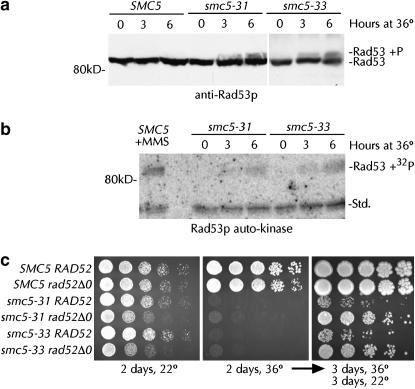Figure 3.
DNA-damage checkpoint induction in smc5 cells and synthetic viability with rad52Δ0. (a) Lysates from SMC5 (yGC141), smc5-31 (yGC231), and smc5-33 (yGC233) cells grown at 22° and at 36° for 0–6 hr were probed with anti-Rad53p antibody. (b) Lysates from a were assayed for Rad53p auto-kinase activity in situ after refolding on the membrane. SMC5 yGC141 cells exposed to 0.033% MMS for 2 hr served as a positive control for Rad53p activation. An unidentified lower-molecular-weight kinase (std) serves as a loading control. (c) Fifteen thousand, 3000, 600, 120, and 24 cells from log-phase SMC5 RAD52 (yGC141), SMC5 rad52Δ0 (yGC177), smc5-31 RAD52 (yGC231), smc5-31 rad52Δ0 (yGC182), smc5-33 RAD52 (yGC233), and smc5-33 rad52Δ0 (yGC185) cultures were grown on YPAD for 2 days at 22° or 36°. After 3 days at 36°, the plate was placed at 22° and allowed to grow for a further 3 days.

